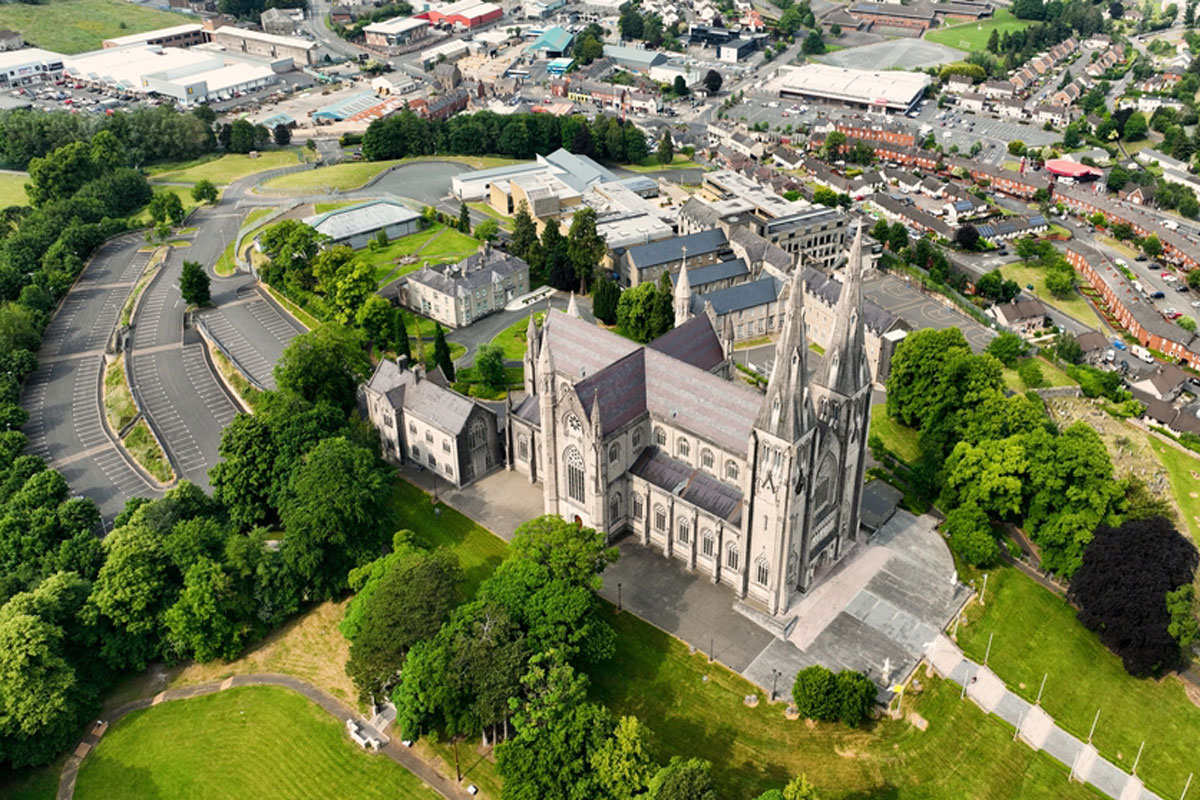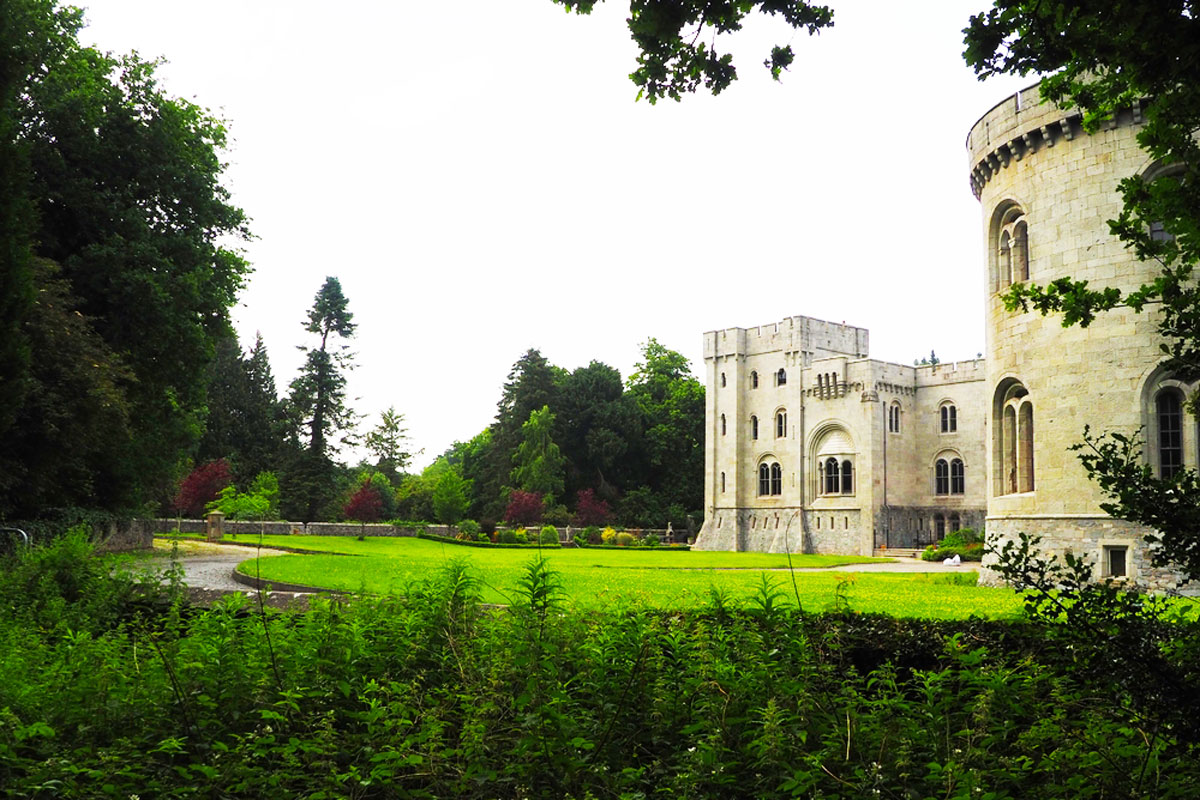An Introduction to St. Patrick’s Cathedral (Roman Catholic)
Standing as a breathtaking example of Gothic Revival architecture, St. Patrick’s Cathedral in Armagh is a place of deep spiritual significance and historical grandeur. As one of Ireland’s most revered places of worship, the cathedral is a symbol of faith, resilience, and architectural brilliance.
Perched on an elevated site, the cathedral dominates the skyline of Armagh, the ecclesiastical capital of Ireland. Its twin spires, intricate stonework, and stunning stained-glass windows make it a landmark that attracts pilgrims and visitors from around the world. Dedicated to St. Patrick, the patron saint of Ireland, the cathedral continues his legacy, serving as the seat of the Catholic Archbishop of Armagh and Primate of All Ireland.
Beyond its religious significance, the cathedral is a masterpiece of 19th-century craftsmanship, reflecting both the spiritual devotion and artistic excellence of the era. Every detail, from its soaring vaulted ceilings to the ornate interior, tells a story of faith and dedication.
Architectural Features and Design
The Cathedral is a stunning example of Gothic Revival architecture, blending intricate craftsmanship with spiritual symbolism. Designed to inspire awe and reverence, its soaring spires and elaborate details make it one of the most magnificent religious structures in Ireland.
Gothic Revival Influence
The cathedral was designed in the Gothic Revival style, a 19th-century architectural movement that sought to revive the grandeur of medieval Gothic churches. This style is characterized by pointed arches, ribbed vaults, and flying buttresses, all of which can be seen in the cathedral’s exterior and interior design.
The Striking Exterior
The first thing visitors notice about St. Patrick’s Cathedral is its twin spires, which rise dramatically above the city of Armagh. These spires, along with the intricately carved stone façade, give the cathedral an imposing yet graceful presence. The main entrance features richly decorated doorways, adorned with religious symbols and figures that reflect the deep spiritual heritage of the site.
The Magnificent Interior
Stepping inside, visitors are met with a breathtaking sight. The cathedral’s high vaulted ceilings and slender columns draw the eye upward, creating a sense of height and openness. One of its most striking features is the collection of stained-glass windows, which bathe the interior in colorful light, depicting biblical scenes and saints in exquisite detail.
The altar and sanctuary are adorned with finely carved wood and marble, while the elaborate mosaics that line the floors and walls tell the story of St. Patrick and the rich Christian heritage of Ireland. Every aspect of the design—from the ornate pulpit to the delicate tracery of the windows—demonstrates a commitment to both beauty and devotion.
The cathedral’s architecture is more than just a visual masterpiece; it is a spiritual experience, designed to elevate the soul and inspire worshippers.
History and Construction of St. Patrick’s Cathedral
The history of St. Patrick’s Cathedral is one of faith, perseverance, and dedication. Though Armagh has long been considered the ecclesiastical capital of Ireland, the construction of this grand cathedral was a monumental undertaking that spanned decades and faced numerous challenges.
The Vision and Beginnings
The idea for a Roman Catholic cathedral in Armagh was conceived in the early 19th century, at a time when Catholicism in Ireland was emerging from centuries of suppression. With the Catholic Emancipation Act of 1829, the Church began to rebuild and assert its presence, and a grand cathedral dedicated to St. Patrick was seen as both a religious and symbolic necessity.
The foundation stone was laid in 1840 under the leadership of Archbishop William Crolly, who envisioned a magnificent Gothic Revival cathedral that would serve as the spiritual heart of Catholic Ireland. However, the Great Famine (1845–1852) caused major delays, as resources were diverted to aid the suffering population. Construction slowed dramatically, and Archbishop Crolly did not live to see its completion.
Completion and Dedication
After years of intermittent progress, the project gained momentum in the late 19th century under Archbishop Daniel McGettigan and was finally completed in 1873. The cathedral was dedicated on August 24, 1873, in a grand ceremony attended by clergy, dignitaries, and thousands of worshippers from across Ireland.
Later Renovations and Enhancements
Over the years, the cathedral has undergone several renovations to preserve and enhance its beauty. One of the most significant was in the 20th century, when the interior mosaics and frescoes were added, further enriching the cathedral’s spiritual and artistic appeal. Modern conservation efforts continue to ensure that St. Patrick’s Cathedral remains a place of worship and heritage for future generations.
From its humble beginnings to its grand completion, the history of St. Patrick’s Cathedral is a testament to the resilience of the Catholic faith in Ireland.
Spiritual Significance and Role in Religious Life Today
Beyond its architectural beauty and historical legacy, St. Patrick’s Cathedral remains a vital center of faith, worship, and pilgrimage. As the seat of the Catholic Archbishop of Armagh and Primate of All Ireland, the cathedral plays a crucial role in the religious life of the country, upholding the spiritual traditions of St. Patrick, to whom it is dedicated.
A Place of Worship and Devotion
Every day, the cathedral welcomes worshippers, clergy, and visitors who come to experience its sacred atmosphere. Daily Masses, special liturgies, and major religious celebrations are held here, attracting people from across Ireland and beyond. The cathedral also serves as a venue for ordinations, confirmations, and other key sacramental events, reinforcing its status as a spiritual cornerstone of the Catholic Church in Ireland.
Pilgrimage and Connection to St. Patrick
As Armagh is the traditional seat of St. Patrick’s ministry in Ireland, the cathedral is a significant pilgrimage site. Devotees visit to honor the legacy of St. Patrick, seeking inspiration from his mission to spread Christianity across the island. Pilgrims often explore the statues, mosaics, and stained-glass windows that depict his life and teachings, deepening their connection to Ireland’s patron saint.
Community and Outreach
The cathedral is more than just a place of prayer—it serves as a hub for community outreach and charitable work. Local parish initiatives, youth programs, and charitable events take place throughout the year, fostering a sense of unity and service. The clergy and volunteers work to support the needy, promote education, and encourage spiritual growth within the community.
A Living Symbol of Faith
Even in the modern era, St. Patrick’s Cathedral continues to inspire faith and devotion. Whether through silent prayer, grand ceremonies, or acts of service, the cathedral remains a testament to the enduring strength of Catholicism in Ireland.
Art, Relics, and Treasures of St. Patrick’s Cathedral
St. Patrick’s Cathedral is not only a place of worship but also a treasure trove of religious art, sacred relics, and intricate craftsmanship. Every detail within the cathedral tells a story of faith, heritage, and devotion, making it a cultural and artistic landmark as well as a spiritual sanctuary.
Magnificent Stained-Glass Windows
One of the cathedral’s most striking features is its stained-glass windows, which bathe the interior in a kaleidoscope of colors. These windows depict scenes from the life of Christ, the Virgin Mary, and St. Patrick, along with intricate biblical and ecclesiastical imagery. Designed by some of the finest stained-glass artists of the 19th and 20th centuries, they serve as visual narratives of faith and devotion.
Mosaics and Frescoes
The richly decorated mosaics and frescoes that adorn the walls and ceilings of the cathedral are among its most admired artistic elements. These intricate works illustrate key moments in Christian history, including St. Patrick’s mission in Ireland. The sanctuary’s detailed designs, with gilded patterns and symbolic motifs, elevate the spiritual experience of those who enter.
The High Altar and Tabernacle
At the heart of the cathedral stands the majestic high altar, crafted from fine marble and adorned with religious iconography. The tabernacle, holding the Blessed Sacrament, is a focal point of reverence, beautifully framed by ornate woodwork and gold detailing. The craftsmanship reflects the deep sense of reverence placed on the Eucharist and the sacred traditions upheld within the cathedral.
Relics and Sacred Artifacts
The cathedral is home to several religious relics, including those associated with St. Patrick and other Irish saints. These relics attract pilgrims and visitors who seek to connect with Ireland’s deep-rooted Christian heritage. Additionally, sacred vessels, chalices, and vestments used in important liturgical ceremonies are preserved as part of the cathedral’s rich ecclesiastical history.
A Testament to Faith and Art
The combination of artistic mastery and spiritual symbolism makes St. Patrick’s Cathedral a true masterpiece of faith and culture. Every mosaic, carving, and window tells a story of devotion, ensuring that the cathedral remains not only a house of prayer but also a monument to Ireland’s religious and artistic heritage.
A Timeless Legacy
For centuries, St. Patrick’s Cathedral has stood as a beacon of faith, history, and artistic beauty. Whether admired for its breathtaking design, visited for its sacred relics, or cherished as a place of deep spirituality, it remains one of the most important landmarks in Ireland’s religious and cultural landscape.
Historical and Cultural Sites
- Navan Fort (Emain Macha) – An ancient ceremonial site with ties to Irish mythology.
- St. Patrick’s Cathedral (Church of Ireland) – A stunning cathedral in Armagh City with historical significance.
- St. Patrick’s Cathedral (Roman Catholic) – Another magnificent cathedral dedicated to St. Patrick, showcasing Gothic Revival architecture.
- Armagh County Museum – Ireland’s oldest county museum, featuring a collection of local artifacts.
- Milford House Museum – A historic mansion offering insights into 19th-century life.
Natural Attractions
- Gosford Forest Park – A large park with walking trails, picnic areas, and a stunning arboretum.
- Lough Neagh – The largest freshwater lake in Ireland, perfect for boating, fishing, and birdwatching.
- Clare Glen – A picturesque wooded area with trails along the River Cusher.
- Slieve Gullion Forest Park – Featuring scenic drives, hiking trails, and a legendary mountain with mythological significance.
Gardens and Scenic Spots
- The Argory – A National Trust property with a charming house and beautiful gardens.
- Tannaghmore Gardens – Home to rare breeds of farm animals and a picturesque landscape.
Religious and Spiritual Sites
- Armagh Observatory and Planetarium – Combining a working research observatory with engaging exhibits on space and astronomy.
- St. Patrick’s Trian Visitor Complex – A center dedicated to the life and legacy of St. Patrick.
Unique Experiences
- Dan Winter’s Cottage – A historic site associated with the origins of the Orange Order.
- Brownlow House – A 19th-century manor house with historical exhibits and a café.
County Armagh is rich in history, natural beauty, and cultural heritage, making it a fascinating destination for all types of visitors.
Helpful Resources






